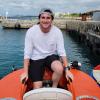Hello everyone!
I am honored to introduce our interdisciplinary team, which has experienced exponential growth over the past year, comprising individuals such as @Rhinecanthus, @stefpap, @aldemar, and @dantzker. In collaboration with institutions including the Smithsonian Institution, Cornell University, FishEye Collaborative, and the Curaçao Sea Aquarium/Substation, we have achieved a significant milestone. Our team successfully tested the first iteration of a low-cost, long-term passive acoustic recorder at depths of up to 200 meters and captured sounds, utilizing a manned submersible. Due to this success, we decided that we needed to take the next steps to improve and make this a usable system for others...
Our WILDLABS 2024 project has two primary objectives:
- To design and manufacture a custom recorder with high signal-to-noise ratio (SNR) and sensitivity specifically tailored for fish, capable of operation at depths of up to 500 meters, all while ensuring scalability and affordability.
- To develop an unmanned solution for the deployment and retrieval of long-term recorders, utilizing the BlueROV2. This unmanned solution aims to streamline the process of deploying and recovering recorders, enhancing efficiency and reducing costs associated with ongoing monitoring and research efforts.
We are already underway with PCB design and deployment strategy! We are always looking for collaborative efforts, so please do not hesitate to reply in the discussion with questions or suggestions.
A basic question is why go deep? - The deep reef (40-300 meters), also known as the forereef or the mesophotic/rariphotic, represents an extension of shallow reef ecosystems, hosting photosynthetic corals, demonstrating unique biodiversity, and extending previously known spawning/resting grounds for your typical shallow fish species. However, a significant challenge arises: marine protected areas can only effectively monitor 20-40% of reef biodiversity hotspots due to the conventional depth limitations of scuba and marine technology, typically restricted to depths of 40 meters. To address this issue, there is a pressing need to develop commercially available tools capable of assessing, monitoring, and enforcing conservation efforts in these deeper ecosystems continuously and over large timescales, all while remaining affordable for conservation agencies.
In response to this challenge, we are developing FinDrop. FinDrop will be a recorder that focuses on capturing sounds produced by fish within the frequency range of 0-10kHz. By leveraging these sounds, FinDrop, coupled with the growing realm of fish species-specific calling classification and bioacoustics in general, should enable further marine conservation technology development that can assess fish occupancy, inter and intraspecific interactions, as well as anthropogenic disturbances within deep reef environments over an extensive spatiotemporal scale.
I’m excited to be providing updates as we go and hope to hear thoughts, comments, questions, and concerns from others as we progress!
Cheers!!
7 April 2024 6:07pm
Congrats @MattyD797 and team!!! We do a lot of work in the underwater bioacoustic realm and your tool certainly seems like it would be a great instrumental addition to the community. Look forward to learning more about your project!
Liz



Liz Ferguson
Ocean Science Analytics